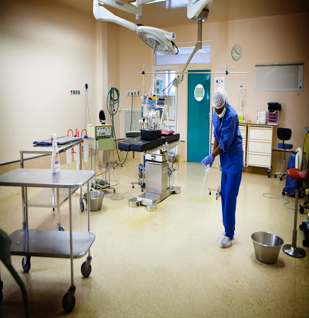Have you ever wondered about the function and operation of an Operating Room (OR)? Unless you are a sales representative that routinely sells into the Operating Room or are a health care worker working within the Operating Room, you may be unaware of what actually occurs within this very unique environment. Here is our Top 10 List of what patients, other hospital personnel, sales representatives that sell into other areas of the hospital and interested individuals may want to know about the surgical milieu.
Last week in Part 1 of this blog we shared with you the OR environment. This week in Part 2 we will discuss the OR function and operation.
-
Patient Safety Checklist/ Timeout
Patient safety is a huge priority for the hospital. Prior to surgery, the circulating nurse goes over a series of questions with the anesthesiologist to ensure the patient has confirmed the procedure, their identity, consent, known allergies etc. Then there is another checklist done prior to the surgeon making his first cut. At this time the nurse, surgical tech and the anesthesiologist go over a series of questions with the surgical team including the patients name, procedure being done, and a count of instruments, needles and sponges. Lastly, before the patient leaves the room another count is done to ensure all the needles, instruments and sponges have been accounted. For more information on this topic see our blog on May 20, 2014.
-
Sales representatives are often in the operating room
 You are probably wondering why there is a medical sales representative in the OR during surgery. Well, here is why. For years the manufacturers have often provided the surgical instruments along with a consignment of their various implants or other products along with a knowledgeable sales representative.
You are probably wondering why there is a medical sales representative in the OR during surgery. Well, here is why. For years the manufacturers have often provided the surgical instruments along with a consignment of their various implants or other products along with a knowledgeable sales representative.
This was done to eliminate the hospital from having to buy a large inventory of product and the associated surgical instruments that are required by each surgeon. In addition, because the sales representatives are knowledgeable about their own products and devices, they are able to assist the surgeons who use them during surgery, by suggesting one product versus another. This can ultimately help speed up the surgery, which provides more turnover of the rooms. This allows the hospital to schedule more cases per day.
While a sales representative may suggest a product to be used during surgery, it is the surgeon who actually decides which products and procedure is best for the patient, not the sales representative.
Before being allowed in the OR, all medical sales representatives must complete and pass three different tests. These courses are a blood borne pathogens test, an OR Protocol test, and a HIPPA compliance test. After these tests are passed, the sales representative will carry a card with them at all times verifying their successful completion.
Having a sales representative in the operating room is not without controversy.3 Some hospitals believe they are an expensive luxury that drives up their cost. As a result several manufacturers have developed a rep-less model whereby they sell their products direct to the hospital at a savings of 40% or more.4
-
Compression booties
Compression booties are inflatable leg wraps that are placed around the patients legs during surgery. They are worn because blood clots are huge risk in surgery. If a blood clot forms in the veins of the patient’s legs then they could travel to a lung. If this occurs then they are at risk for a pulmonary embolism, which is very dangerous. So it is vital for the patient to wear compression booties during surgery to keep the blood flowing. These will typically be worn until they are up and walking following surgery and sometimes longer.
Once the surgery begins, the compression booties inflate and deflate to massage their legs. They move the muscles around to help prevent blood clots. Normally, when patients are asleep in their own bed, they move their legs around. In surgery they may be in the same position for several hours so the booties are a necessity.
-
Latex Allergies
Latex allergies are taken very seriously. If you as a patient have a latex allergy then please note the following precautions are taken for your safety.
- Synthetic gloves will be worn by everyone in contact with you
- Signs are attached to all entrances in the room
- The OR must be latex free 3 hours prior to surgery
- The table and arm boards must be covered in linens
- The surgical staff must be in clean clothes and thoroughly wash their hands to ensure they have removed any latex powder
-
Disinfection
 The hospital follows strict guidelines when it comes to cleaning their operating rooms. Before the surgical procedure occurs, housekeeping comes in and damp dusts all the surfaces in the room. This includes surgical lights, and any equipment in the room. They will use a microfiber cloth with an EPA-registered disinfectant. In addition, any equipment outside of the room will be cleaned prior to entering a clean OR.
The hospital follows strict guidelines when it comes to cleaning their operating rooms. Before the surgical procedure occurs, housekeeping comes in and damp dusts all the surfaces in the room. This includes surgical lights, and any equipment in the room. They will use a microfiber cloth with an EPA-registered disinfectant. In addition, any equipment outside of the room will be cleaned prior to entering a clean OR.
Between surgical procedures and after the patient has been moved, housekeeping will disinfect the room wearing clean gloves and using a clean microfiber cloth with the EPA-registered disinfectant. They will use these to clean all the furniture, surgical lights and equipment in the room. They also mop the floor with a disinfectant solution. The next patient will not be brought into the OR until everything has dried.
At the end of the day and after the last surgical procedure, the housekeeping crew will come back in and thoroughly disinfect the entire OR. They will move all standing equipment to clean the entire OR floor. If there is anything in the room that can be dissembled, the crew will take it apart, clean it and put it back together.
Alcohol products are not be used to clean the rooms since it is flammable.
Parting Thoughts
Unless you routinely work in the operating room it is an unknown and unfamiliar place to most people. Our intent in this blog was to provide you with some basic knowledge to increase your understanding and appreciation of this milieu. As always, we welcome your thoughts and insights.
References
- Implant Strategies for Today. IDNs and vendors agree: standardization no longer enough. Journal of Healthcare Contracting April 2015 22-27.
- Lee, Jaimy. Devicemakers being replaced in the OR. Modern Healthcare August 16, 2014


